Many car books come on the market each year. This is the story of how an author became obsessed with one race driver and the cars he created and who covered the same subject in two different books written 30 years apart…
Mike Gulett
by Wallace Wyss –
There are some auto historians that write about cars that they have never seen, but in the case of the cars of Shelby American, my interest in the marque was piqued way back in the Sixties, while I was in high school in the Detroit suburbs and nightly cruising Woodward Ave. Not often to drag race (usually I was in the pedestrian family car) but just to see what was out there. Occasionally I would see a guy in a small block (289) white Cobra who would beat everyone, and I thought “someday I’m gonna learn more about that car.”
Then, in 1969, I moved to California. One day I saw a red 427 Cobra on the freeway. I began to follow it and its driver, fearing a carjacker, sped up. Finally I was doing 90 MPH in the Toyota trying to catch him and the angry Cobra owner pulled off the freeway into his driveway and angrily asked: “Why are you following me?”
I identified myself as a photographer and said I wanted to shoot pictures of his car. Well, we scheduled the shoot and I prevailed upon Carroll Shelby himself to come along to the shooting location in Playa del Rey near his office and pose standing by the car. Shelby, who was surprisingly modest considering his dynamo aura, was sort of bemused at the invitation.
This was the early ‘70s and Shelby had left Ford and gone to Africa to run a game preserve and come back to find he was almost forgotten. This was, you understand, before vintage racing got big and before the big car auctions and before the first Cobra replicas hit the street. He got a kick that anybody even cared about old Cobras. (The story appeared in Germany’s Auto Motor und Sport and the Cobra owner –a shop owner in the San Fernando Valley–recently sold his car decades later, trading it for a modern Ford GT and cash).
FINDING A PUBLISHER
At some point around 1976 I called an automotive book publisher, Motorbooks, in Wisconsin (founded by Brit immigrant Tom Warth), and asked them, “Say, do you want a book on Ferrari?”. Their publisher, Tom Warth, said “There’s too many books on Ferrari. We’re looking for someone who wants to write a book on the Cobra.”
I told him, “No thanks, I like foreign cars” but then a couple days later I realized, hey, what the hey, I wasn’t working at the time, so why not? So I called him back and told him I would do it. That biography of a man and his cars came out on the market entitled “Shelby’s Wildlife: the Cobras and the Mustangs.”
Incidentally, Warth, a car collector, bought a 289 Cobra a few years later, and in the early 2000s asked me what auction he should sell it at and I told him the Gooding at Monterey and I think it hammered down and sold at over $600,000 or over 100 times what a Cobra was worth when I first wrote Shelby’s Wildlife! (And now they have gone to as high as $900,000, depending on condition, originality and ownership history!)
I was starting out on the project with scant reference material. In fact, the only printed information I had on Cobra at the time was a tiny little 22-page register from a defunct Cobra owner’s club in Grosse Pointe, Michigan which had little details on each of the club members’ cars. That had been given to me by Ed Durston, an employee of a used car lot on Sunset strip, a lot that improbably, sold nothing but old Rolls Royces!
The fascinating thing about Shelby was his method of working—his behind-the-scenes projects that, when they didn’t work out, were sold downriver. For instance, he had a one-off mid-engined car called the Lone Star, built late in the big block Cobra production run. Ford was antsy to get out of backing Cobra production and didn’t even want to look at it, with the result that it became sort of a pariah on the collector car market, yet to be recognized as he significant car it is. And yet I found that many employees who worked at Shelby American had never seen it!
The book came out in hardbound form in 1977. I was able to use many of the pictures given to me by Paul Preuss, a PR man working for Ford Motor Co. HQ in Dearborn who wanted that history saved rather than tossing them to make room for the 1972 Pinto or whatever.
Shelby himself wrote the introduction. The cover was painted by David Falconer, an Arizona artist who has a unique and subtle style with colored pencils.
The book sold 50,000 copies, including a second softbound edition where I included the Dodges, which I now regret doing, since in the history of Shelby-American, the front drive Dodges are of little note or importance.
I figure that the reason the book Shelby’s Wildlife went out of print after 17 years was because various other authors chimed in with Shelby books and Cobra books, so pretty soon just about every tiny little fact on each model was known. (Well, not everything– I still have yet to read even a paragraph in any Shelby book explaining who commissioned the Zagato GT350 or the one-off Ghia Cobra roadster and where the latter is…?)
But there was still the human story that wasn’t being fully told. For decades I kept wondering: “How can I tell this Shelby story from a new angle?”
TOM WOLFE PROVIDES THE MODEL
Then I realized that I had the answer on my bookshelf all the time. Back in 1965, a chance meeting on Hollywood Boulevard was with Tom Wolfe, a colorful writer whose first book was the Tangerine Colored Streamline Baby and later he became famous for writing The Right Stuff (about the astronauts) and his books made me realize there’s more than one way to tell a story. You can tell it in a more folksy way even if it’s a biography. Plus the advent and universality of the internet was a game changer for car books. With the advent of the net, it is really no longer necessary for an author writing about cars to clog up a car book with endless lists of gear ratios, paint
colors, etc. because you can find just about any fact like that on Yahoo or Google in seconds. (Test yourself: go on the net and ask what’s the cfm of the carburetor on a 1965 Shelby GT350? Answer: 750 cfm. That search should take you 5 seconds on Google.)
True there are still car fans who want books with those facts but I think Michael Antonick’s Corvette Guides are the model there, those being naught but a year-by-year listing of what equipment was available on each model year by year.
So decades after that first book went out of print, my original publisher, Tom Warth, left MBI and started a new firm called Iconografix. His original intention at the new firm was only to do picture books so we did one on Corvette dream cars, one on Porsche 356s and so forth but I still wanted to try out my new concept for a Shelby book. I knew Warth was a Cobra owner and, as a rare book vendor in a separate business (http://www.tewarthautobooks.biz/), he was constantly being asked for old copies of Shelby’s Wildlife. But knew that was obsolete because that book was written in 1977 and Shelby had done a whole lot of stuff since then.
In the middle of the first decade of the 21st century, I pointed out to him that it had been, oh 30-plus years since the original Shelby book had hit the press and Shelby had continued to do many things in the auto industry, so why not do a new biography in a new exciting way? Bring the readers up to date on Shelby’s career so to speak.
I was a little worried about competition, though. A rough patch late in Shelby’s life was the ill-fated Olds-powered Series I venture, a sports car designed and built in America (as opposed to the Cobras which had their chassis and bodies done in the UK)
What was worrying me was that I knew Eric Davison, an ad executive I had worked with in Detroit when I was a copywriter, had been involved with the Shelby Series I when I was doing some ad copywriting for the boutique agency Davison had co-founded in California. He told me he intended to do a book on Shelby.
I was stymied, thinking: “Why should I do a Shelby bio when Eric’s doing it?”, but then he confided a few months later that he had decided to narrow down his scope to solely concentrate on the Oldsmobile-related venture, which was Shel’s biggest flopperoo, since Davison had been personally involved in that. That decision of Davison gave me the courage to go full steam ahead on an all new complete biography. Davison’s book Snake Bit: Inside Carroll Shelby’s Controversial Series 1 Sports Car did come out from Motorbooks and was successful in providing insight into Shelby’s big mis-adventure in developing a modern state of the art car.
I told Warth I was ready to go and he said “OK”, to a rough draft of an all new book, to be about 50,000 words, which I finished in about three months. Much of it was written in so-called “stream-of-consciousness” style like Tom Wolfe—me just pouring out the chronology as I remembered it (and later checking what I had written against other books when it was still in rough draft).
THE SNAKE STRIKES
Now what about re-interviewing Der Snakemeister? Ah, no. While Shelby had been co-operative with the first book, granting an interview or two and writing the forward, this time around he kept the barriers up, and even kicked me off the invite list for various introductions of Shelby products such as the 2007 Shelby Mustang.
I figured that was because there were a couple of things he didn’t want dredged up in a biography, not only the Oldsmobile fiasco, but things like the time he told the world that he had discovered some old 427 chassis that he had plumb forgot about and began building them up for sale, using previously existing serial numbers for cars not built. What Shelby didn’t know was that I happened to have met a fellow member of the Bel Air Country Club (of which Shelby belonged to) who told me that Shelby had approached him with a request to build some chassis so I knew the inside story, but anyway I was able to write the book without Shelby’s co-operation, and quote from some of the interviews he had done since my first book.
So this new biography was “unauthorized” you might say. I figure any biographer who writes a book about a subject and then goes ahead and voluntarily “self censors” the book so as not to offend the subject of the book is not writing a real biography.
Those books, in the library, should more correctly be filed not under “History” but under “PR puffery.” Contrary to what Shelby might have thought, I was not out to do a hatchet job on him. Shelby, since my teenage days, has always been one of my heroes, along with Phil Hill, Masten Gregory and Stirling Moss. They were all yanks over there in Europe racing Europe’s best sports cars in the Fifties and beating the Europeans at their own game. Plus there was that whole rags-to-riches story that made his story more appealing. Sure we had rich Americans like Lance Reventlow and Jim Hall buying the fastest foreign cars money could buy but it’s quite another thing to work yourself into a world class driving slot when you started out in life picking cotton at 25 cents per hour. And the Texan angle appealed to me too (like Shelby, I logged some time on horseback, mine in Montana, but that’s another story…) And as a former ad writer, I feel Shelby’s marketing successes are a story that needs to be available to a new generation.
A RIVAL BOOK FROM THE UK
A few years after SHELBY: The Man, the Cars the Legend came out from Enthusiast Books (a subsidiary of Iconografix, in 1977), a British writer, Rinsey Mills, a man who, ironically had been critical of the Cobra in magazine articles, was backed by Motorbooks to write a huge biography of Shelby, entitled Carroll Shelby: The Authorized Biography, which emerged as a huge doorstop of a tome that was an intimidating 552 pages, hardbound, and weighed over two pounds. Was I worried his book would kill off my book? A tad. But then I got a review copy and saw that Mills had pussy-footed around some of the more delicate subjects so as not to suddenly have Shelby’s co-operation revoked.
There are pictures in Mills’ book of him at Shelby’s house doing interviews, so you know he had exclusive access. Still I have to say that his book is worth reading for serious Shelby scholars because, being based in England, Mills was able to interview many of the people who were involved with Ford’s Le Mans program and the building of the Cobras. And, to his credit, he did include one story worthy of a plot for daytime soap opera—the time Shelby’s wife in Texas came up to California and insisted on confronting Shel’s movie star girlfriend in the apartment Shelby shared with the actress. (Shelby later married the actress but she dumped him just before he hit pay dirt with the Cobra).
Where Mills’ book let me down, and made me glad I had decided to take a more folksy “down home” approach than is normally done, is that Mills constantly showboats his vast knowledge and unrestrained budget by going off on irrelevant tangents. For instance, you mention “Africa” ,he immediately would give you ten pages on the history of various African countries that Shelby may have hunted big game in. I thought all American readers wanted to know is: what was Shelby doing in Africa and why did he leave? All of which could be handled in a paragraph. Later Motorbooks re-printed the Mills’ book in paperbound form at a lower price, so I see they followed my approach–the Shelby book market wants a book you can carry around, not one that could be used as a foundation for a bridge.
I also envisioned my book as a smaller softbound book that could be carried around at an event. And going paperbound from the outset could allow us to go for a lower price. Sad to say, printed book readership has fallen mightily but maybe, just maybe, I thought a price around $20 would still make Shelby:The Man, the Cars, the Legend appealing to those young people who had never been in the habit of buying books. As someone who has grown up with books I am still shocked to meet young people—millennials and those nameless generations that followed—who don’t own a single book, and who don’t have a bookshelf at their home.
A UNIQUE COVER FEATURING FIVE GREAT DRIVERS
There’s even a story to tell about the cover of the book. Why a black and white picture? A good question to ask when, being a fine artist, I could have painted a nice color portrait, and the fact that, in my archives, there are hundreds of Cobra pictures I have taken since the year 1965, when I first visited Shelby-American at their LAX factory. The reason why I chose that particular old black and white photo is that it is such a great picture. I came across it at the Long Beach Swap Meet–a shot of Shelby with several racers taken at Sebring in 1965 and bought it for $50. What makes the picture so poignant is that three of the racers in the picture with Shelby later died at the wheel of a race car, so that one photo all by itself illustrates how dangerous a profession race driving was back then.
The drivers accepted the risk, which seemed to me, among the top ranks, like akin to your odds of surviving a B-17 bombing run over Germany in 1944. And in the picture, Shelby looks so iconic, vintage Shelby you might say, the black cowboy hat, the Pete Brock-designed shirt, that one shot has the whole nine yards. I was worried I couldn’t use the picture since there was this former free lance photographer who seemed to be claiming every racing picture shot of Shelby at the time as his but then I found the stamp on the back—Ford’s own racing photographer, one who coincidentally, I had met in Dearborn while wandering the halls of Ford HQ– and thus I knew it was a PR handout shot handed out to every magazine and newspaper at the time. That picture help make the book.
Another photo find I treasure is the one from the Dallas Morning Herald –of Shelby and his happy family in Dallas, when his kids were still little. It’s an interesting picture because Shelby looks about 95% the same but, as I looked at it carefully, I concluded that it was shot before his crash at Riverside in ‘57 where he sliced off his nose. When it was sewn back on, he looked a little different, the way he did for the rest of his life. As if Shelby had a twin brother.
There have been many more Shelby books published since SHELBY The Man, the Cars, the Legend. Some are focused tightly on the Cobras alone, some concentrate only on Shelby Mustangs, and there’s a couple that are picture books that just concentrate on Shelby’s short but accomplished career as a race driver.
So, my advice, if you really want a Shelby library—and want to include everything from books about the man, to books about the actual cars like the Cobras, Shelby Mustangs and GT40s—you’re going to need a bookshelf about four feet wide and a budget of about $500.
TEXAS SAYINGS
One of the things I spent some time trying to add to the new book that wasn’t in Shelby’s Wildlife, was in trying to capture the flavor of how Shelby talked. Even though he lived in Bel Air, a neighborhood that looks down (both altitude-wise and money-wise) on Beverly Hills, from the moment he began to succeed in business, he always continued to act like he just fell off the turnip truck from Texas. This was deliberate, his shtick.
CHANNELING TOM WOLFE
In order to nail down how Southerners talked, I pulled off my bookshelf Tom Wolfe’s novel A Man in Full, a 744-page hardbound about a Southern businessman, and underlined every regional Southern saying in the whole book, which, when pasted down on blank paper, was 20 pages worth. Then I tried to figure out which Southern saying applied to any part of Shelby’s book. After all this, I ended up using only one line, something about how the hero of Wolfe’s book was looked upon by his competition. The line was something like: “They didn’t want him to die, they just wanted him to lie on his back with his paws in the air.” Anybody who owns a dog knows whereof I speak.
I don’t think the late Tom Wolfe would have minded if he had heard that story. In fact I met Tom back when was out on the road promoting his first book and invited him to lunch on Sunset strip. That was, what, more than a half century ago! (And yes indeedy, Wolfe showed up wearing his trademark white suit!)
HOLLYWOOD CALLS (OH-SO –BRIEFLY)
Oh, I would be remiss if I didn’t mention that for one brief shining moment SHELBY: The Man, the Cars, the Legend was courted by Hollywood. Big names were bandied about briefly in the trade paper Hollywood Reporter, mentioning three different production companies involved, world class directors and a famous scriptwriter who had won a few BAFTA awards for screenwriting.
I got some option money, but in the end they didn’t buy it but merely paid money yearly to be first in line if and when they decided to buy it. But then, after three years, no more checks came. I blame the boring race film “RUSH”, which amply demonstrated how racing can be a real bore to the general public if the movie patrons don’t know what’s going on.
But that movie was set in the ‘70s, whereas I think Shelby’s personal rags-to-riches story and the era most of his story took place—the ‘50s and ‘60s–has much more visual attractiveness on screen. But, in truth, racing movies do badly at the box office. In fact, I have a DVD of Mickey Rooney’s 1949 movie, The Big Wheel, a fictional portrayal of an Indy type driver, and that’s got more character development in it than most of the racing movies I’ve seen in the years since.
And so it goes. Many of the genuine A.C. Cobras out there will soon be celebrating their 70th birthdays and are at this writing worth 100 times more than what they were worth when I wrote Shelby’s Wildlife in 1977. I am willing to re-edit SHELBY The Man, the Cars the Legend if there is any new info forthcoming but I think, between myself and Mills, and a passle of Johnny-come-lately historians who weren’t even born when the Cobras roamed the earth, have unearthed most of the secrets of America’s down-home racer.
Let us know what you think in the Comments.
THE AUTHOR/ARTIST: His book SHELBY The Man, The Cars, The Legend is available directly from Enthusiast Books, Hudson, WI (715) 381-9755. Various prints of his Cobra and Shelby artwork are available so contact Wallace direct at mendoart7@gmail.com.
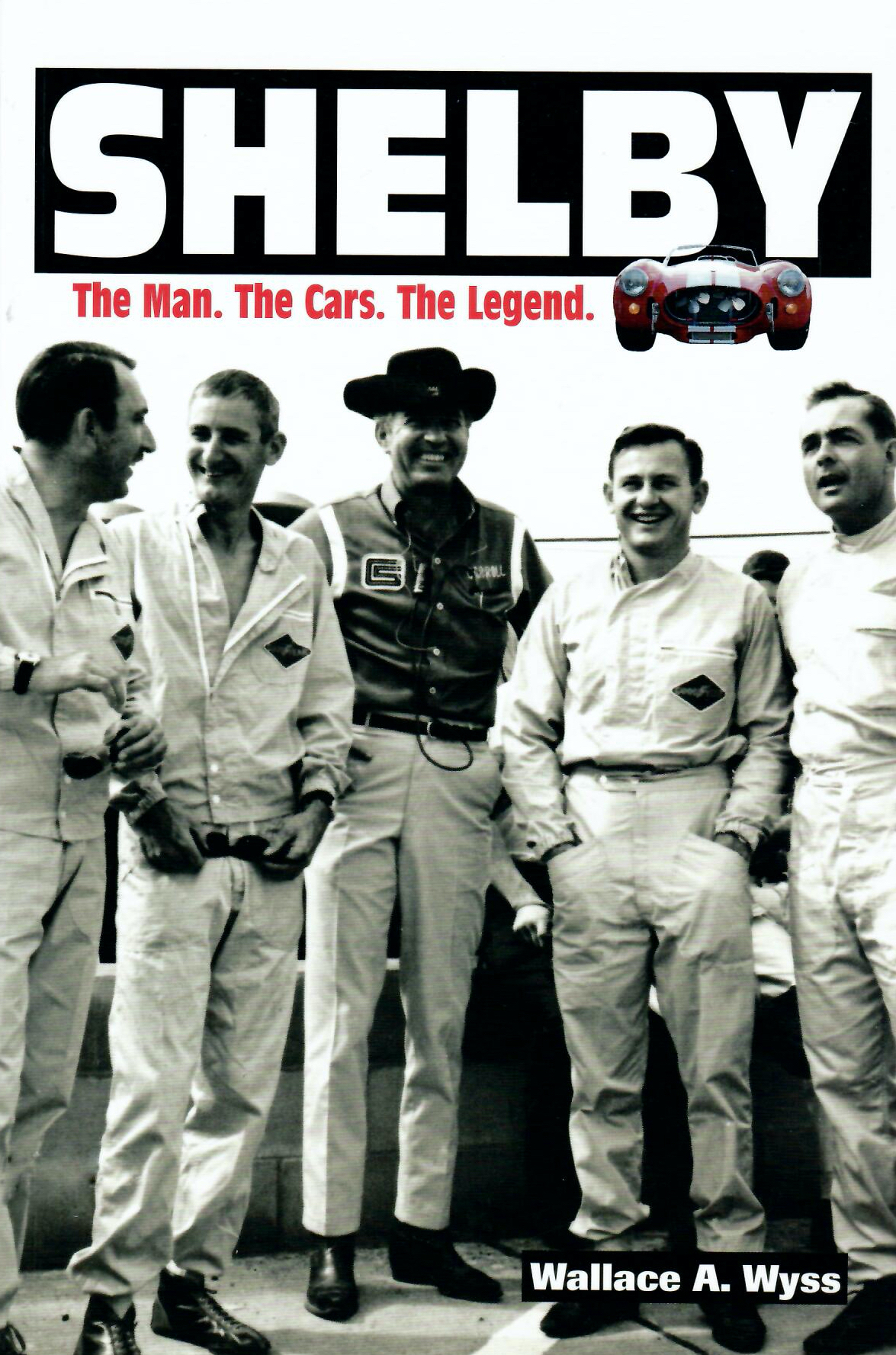
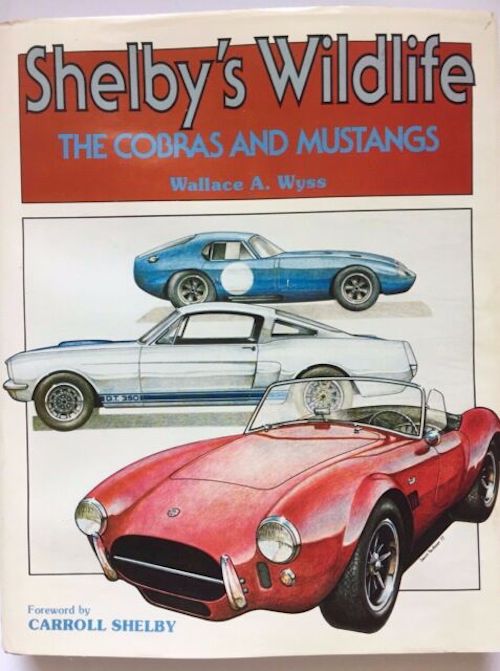
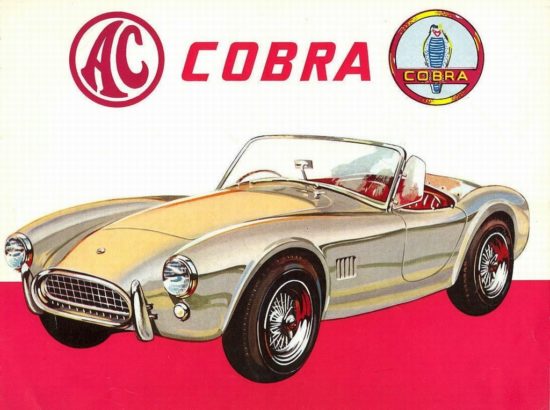
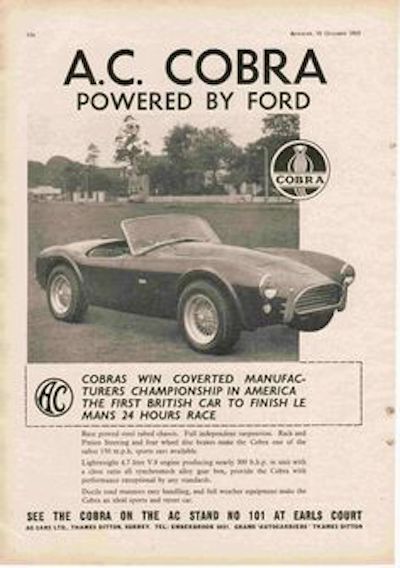
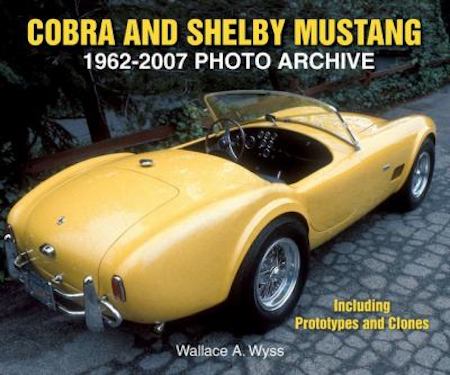
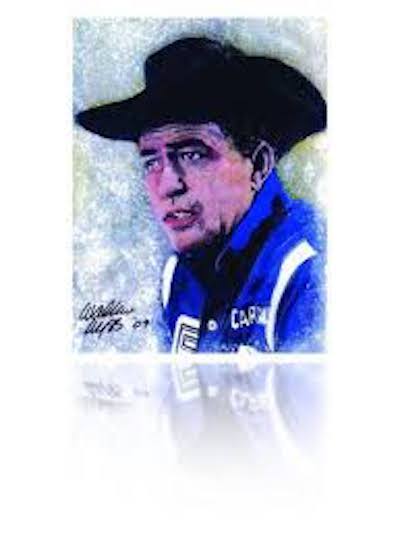
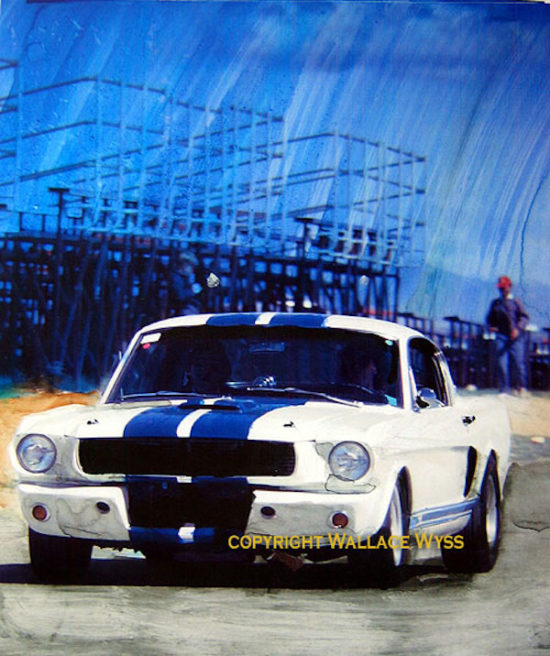
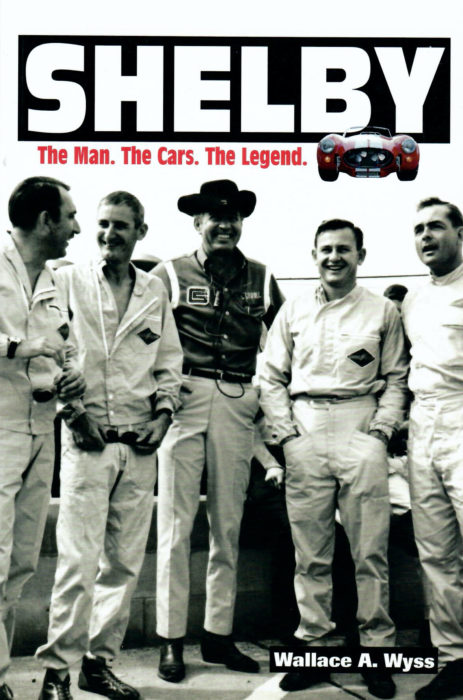
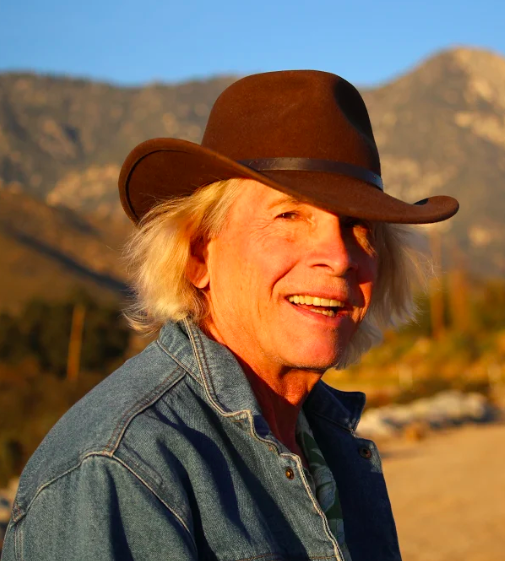
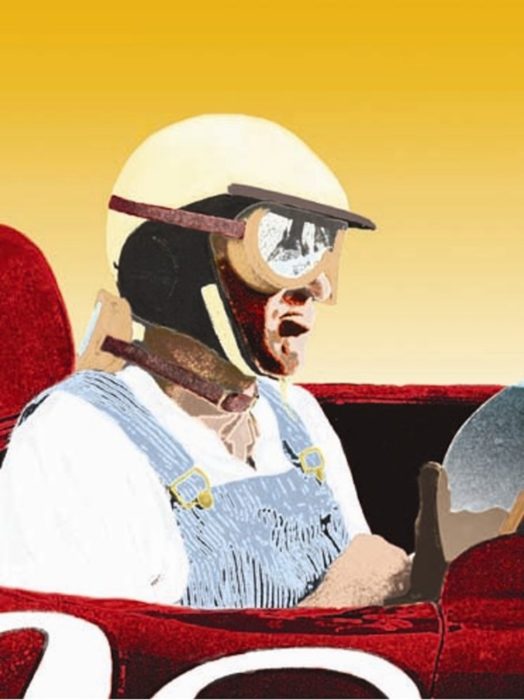


Speak Your Mind